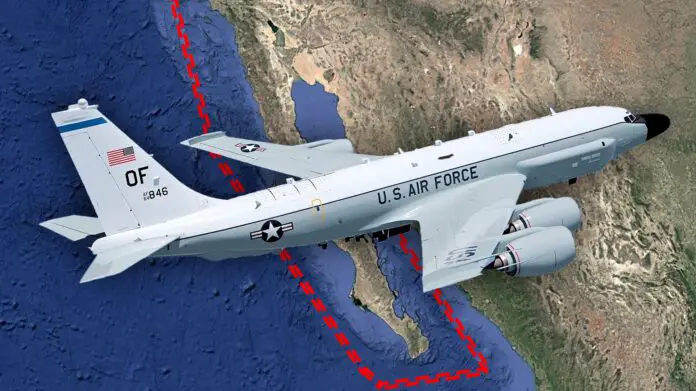A U.S. Air Force RC-135V Rivet Joint conducted an unusual surveillance flight in the Gulf of California, between Mexico’s Baja Peninsula and mainland Mexico. This high-capability intelligence, surveillance, and reconnaissance (ISR) aircraft appears to have repeated the flight the following day, according to online flight tracking data.
Significant Development
The appearance of the Rivet Joint off the Mexican coast marks a significant development amid increased U.S. military support along the Mexico border under President Donald Trump. Discussions have emerged regarding potential direct action by American forces against drug cartels.
Flight Tracking Data
Flight tracking software indicates that RC-135V serial number 64-14845 flew from Offutt Air Force Base in Nebraska to southern California skies on February 3. Offutt is home to the 55th Wing, responsible for most of the Air Force’s Rivet Joint fleet. The aircraft then traveled south along the Pacific coast of Baja California before entering the Gulf of California. It later returned to Offutt via the same route. Additional data shows a similar sortie conducted the following day.
International Airspace
Despite the Gulf of California’s narrowness, it contains international waters and airspace at its center. There are no indications that the RC-135V entered Mexican national airspace during these flights.
Operational Support
The use of RC-135V/W Rivet Joints for Western Hemisphere operations, especially counter-drug missions, is not new. These aircraft frequently support NORTHCOM tasks. Rivet Joint flights in the Gulf of California are rare, if not unprecedented. From this position, the aircraft can monitor the northwestern corner of Mexico, dominated by the Sinaloa Cartel.
Intelligence Capabilities
The RC-135V/W is equipped with advanced signals intelligence (SIGINT) systems to detect and intercept communications and electronic transmissions. The crew, consisting of linguists, electronic warfare officers, and intelligence specialists, can analyze collected data in real-time. This capability helps establish “patterns of life” for individuals or groups, aiding in refining intelligence strategies and planning targeted operations.
Broader Implications
Rivet Joint flights in the Gulf of California provide valuable intelligence on cartel activities, enhancing situational awareness in a critical area. This aligns with the Pentagon’s statements on expanding military presence along the southern border.
Increased ISR Support
The U.S. Navy’s P-8A Poseidon maritime patrol planes are also conducting flights along the Mexico border, demonstrating increased ISR support. The intelligence collected by RC-135V/Ws and other ISR aircraft can be shared with U.S. intelligence and law enforcement agencies to support interdiction operations.
Collaboration with Mexico
Mexican President Claudia Sheinbaum recently pledged to deploy 10,000 troops to combat drug trafficking, following an agreement to avoid a trade war with the United States. This follows a similar agreement by her predecessor, Andrés Manuel López Obrador, in 2021.
Future Actions
Discussions about potential direct U.S. military action against drug cartels, including targeted strikes, continue. Secretary of Defense Pete Hegseth mentioned that “all options will be on the table,” pending President Trump’s decision.
While there are no indications of imminent direct military activity, the presence of Rivet Joint sorties in the Gulf of California signals broader efforts to combat cartel influence in the region.
Source: TWZ




